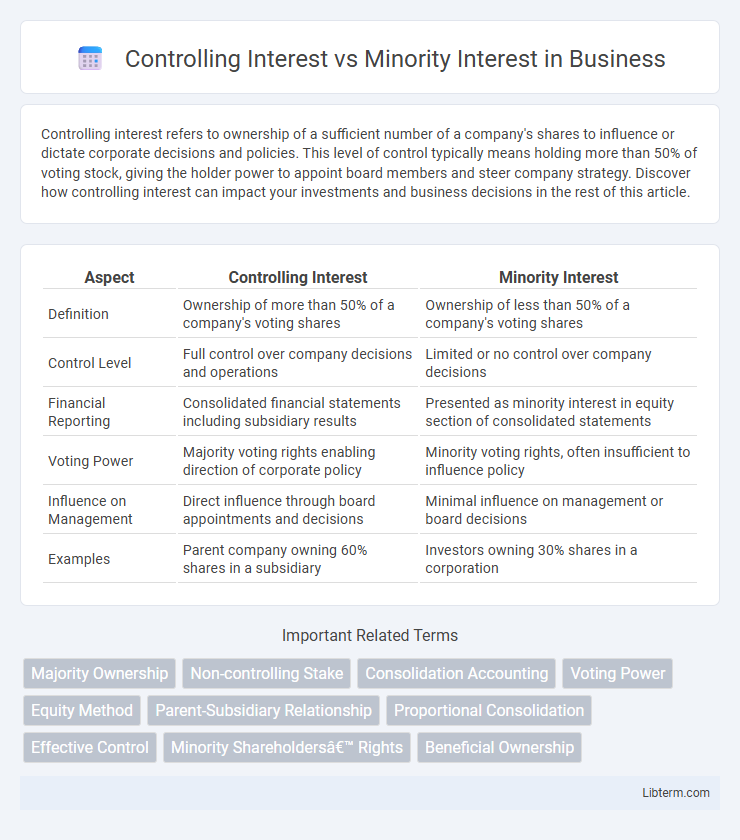Controlling interest refers to ownership of a sufficient number of a company's shares to influence or dictate corporate decisions and policies. This level of control typically means holding more than 50% of voting stock, giving the holder power to appoint board members and steer company strategy. Discover how controlling interest can impact your investments and business decisions in the rest of this article.
Table of Comparison
| Aspect | Controlling Interest | Minority Interest |
|---|---|---|
| Definition | Ownership of more than 50% of a company's voting shares | Ownership of less than 50% of a company's voting shares |
| Control Level | Full control over company decisions and operations | Limited or no control over company decisions |
| Financial Reporting | Consolidated financial statements including subsidiary results | Presented as minority interest in equity section of consolidated statements |
| Voting Power | Majority voting rights enabling direction of corporate policy | Minority voting rights, often insufficient to influence policy |
| Influence on Management | Direct influence through board appointments and decisions | Minimal influence on management or board decisions |
| Examples | Parent company owning 60% shares in a subsidiary | Investors owning 30% shares in a corporation |
Understanding Controlling Interest
Controlling interest refers to ownership of more than 50% of a company's voting shares, granting the shareholder the power to influence and direct corporate decisions and policies. This majority stake enables control over board appointments, strategic direction, and operational management, ensuring dominance in governance. Understanding controlling interest is crucial for assessing who holds the decision-making authority and how consolidated financial statements are prepared.
Defining Minority Interest
Minority interest represents the ownership stake in a subsidiary held by shareholders other than the parent company, typically less than 50% of voting shares. It reflects the portion of net assets and earnings that do not belong to the parent company in consolidated financial statements. Recognizing minority interest ensures accurate representation of control and ownership in group financial reporting.
Key Differences Between Controlling and Minority Interests
Controlling interest refers to ownership of more than 50% of a company's voting shares, granting the holder the power to influence or dictate management decisions and corporate policies. Minority interest, conversely, represents a smaller ownership stake, typically below 50%, limiting the shareholder's influence on company operations and strategic direction. Key differences include the extent of control, influence on financial reporting, and the ability to consolidate financial statements, where controlling interest results in consolidation, while minority interest is reported as non-controlling equity.
Rights and Powers of Controlling Shareholders
Controlling shareholders possess the authority to make key corporate decisions, including appointing board members, setting company policies, and influencing strategic direction, reflecting their majority voting power. Minority shareholders hold limited rights, primarily focused on protecting their investments through minority protections and shareholder agreements but lack the power to unilaterally dictate corporate actions. The dominance of controlling interests enables majority owners to steer company governance, while minority interests safeguard equitable treatment and transparency.
Limitations Faced by Minority Shareholders
Minority shareholders face significant limitations, including lack of control over key corporate decisions and board appointments due to controlling interest held by majority shareholders. Their influence on dividend policies, mergers, and acquisitions is often minimal, reducing their ability to protect their investment interests. Legal protections exist but can be costly and complex to enforce, leaving minority shareholders vulnerable to potential abuse by controlling parties.
Financial Reporting for Controlling vs Minority Interests
Controlling interest represents ownership of more than 50% of a company's voting shares, granting the parent company full consolidation of financial statements, including all assets, liabilities, revenues, and expenses, while reporting minority interest as a separate equity component to reflect non-controlling shareholders' ownership. Minority interest, or non-controlling interest, signifies ownership of less than 50%, requiring equity method accounting with proportional recognition of net income and equity without consolidating full financial statements. Financial reporting standards, such as IFRS and US GAAP, mandate clear disclosure of both interests to provide transparency in ownership structure and financial performance.
Impact on Corporate Governance
Controlling interest grants majority shareholders the power to influence corporate governance through decisions on board composition, strategic direction, and executive appointments, often shaping the company's policies and risk tolerance. Minority interest holders have limited influence, typically relying on regulatory protections and minority shareholder rights to ensure transparency and accountability in governance practices. The balance between controlling and minority interests impacts the effectiveness of oversight, shareholder engagement, and equitable treatment within the corporate governance framework.
Legal Protections for Minority Interests
Legal protections for minority interests include statutory rights such as appraisal rights, which allow minority shareholders to demand fair value for their shares during significant corporate changes. Jurisdictions often enforce fiduciary duties on majority shareholders and directors to prevent oppression or unfair prejudice against minority owners. These protections also encompass access to key corporate information and the ability to seek judicial remedies when controlling interests abuse their power.
Strategies to Gain or Protect Controlling Interest
Strategies to gain or protect controlling interest focus on acquiring a majority of voting shares to influence key corporate decisions and board appointments. Companies may employ tactics such as share buybacks, issuing new shares to friendly investors, or forming alliances with other shareholders to consolidate control. Protecting controlling interest also involves implementing shareholder agreements, poison pills, or staggered board structures to prevent hostile takeovers and dilution of ownership.
Real-World Examples of Controlling and Minority Interests
Controlling interest typically exceeds 50% ownership, granting decision-making power in companies like Berkshire Hathaway's majority stake in GEICO. Minority interest represents ownership stakes less than 50%, such as institutional investors holding small percentages in Apple or Amazon without direct control. These distinctions affect consolidation methods and financial reporting, with controlling interest allowing full integration of financials while minority interest is reported as non-controlling interest on the balance sheet.
Controlling Interest Infographic

 libterm.com
libterm.com